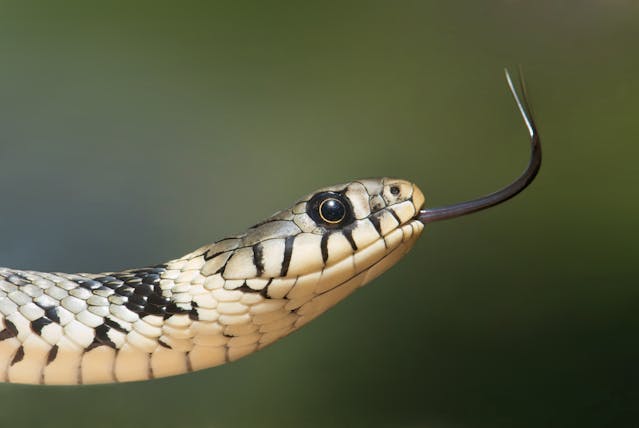
How do snakes use their tongues? They flick them in and out to pick up chemicals off the ground and from the air. Snakes are not the only reptiles that use their tongues to detect things. Lizards have the same kind of tongue that they use to monitor the environment around them.
A lot of animals, birds, and fish have tongues. They don’t all use them for the same purpose. We, and most animals, use our tongues for tasting. They are covered in taste buds which detect the chemical composition of the food we eat. Many animals also use their tongues for cleaning themselves, as we do too if we get chocolate stuck on our fingers. Tongues help many animals to swallow food, to drink, and to make sounds. We wouldn’t be able to talk if it wasn’t for our tongues. Even fish have a tongue, although it is a bony structure and is only really there to protect a large blood vessel they have that passes just behind the mouth.
Snakes and lizards have a very distinctive tongue. Their tongues are usually fairly long, are able to project quite far out of the mouth, have a wide range of motion, and are forked at the end. So, what do the tongues of snakes and lizards do? Well, they don’t taste the air, they smell the air.
The snake’s tongue is tucked away in a sheath in the lower jaw when it is not being used. When they flick it out it goes through a small gap in their lip, which is called the rostral groove, meaning they can flick their tongue out without having to go to the trouble of opening their mouths. Every time the tongue shoots out, chemicals from the air and the surrounding environment land on the tongue. Unlike our taste buds, snakes don’t have any way of tasting with their tongues, so the snake brings the tongue and the chemicals it has picked up back into its mouth. Inside the mouth, the tongue deposits these chemicals onto pads that sit on the floor of the mouth. The same muscles that pull the tongue back in raise these pads up to the roof of the mouth. In the roof of the mouth is something called the Jacobson’s Organ, which is what the snake uses to analyze the chemicals it has picked up.
The Jacobson’s Organ was discovered by Ludwig Lewin Jacobson, a Danish surgeon and biologist. It can be found just above the roof of the mouth and below the brain. It is connected to the mouth by two narrow openings, and it is connected to the brain via nerves. The organ contains many extremely sensitive sensory neurons that are activated by the chemicals that came off the snake’s tongue. They are activated in the same way as a scent activates the olfactory neurons inside our noses. The snake can gain a huge amount of information from these neurons.
Snakes have another adaptation as well. They have forked tongues. The forked tongue does two things. It increases the surface area of the tongue, allowing for more chemicals to land on it. And it lets the snake work out what direction the scent is coming from. If we smell an apple pie cooking, we can turn our head this way and that until we find the strongest stream of scent and we can try to work out where the pie is. Snake’s forked tongues work in a similar way. The two halves of the fork can spread apart and the distance between them will be greater than the width of the snake’s head. When the snake brings the chemicals it caught back into its mouth and they travel up to the Jacobson’s Organ, they are kept on the same side. The chemicals from the left stay on the left and those from the right stay on the right. The Jacobson’s Organ can tell which side of the tongue has more of the chemical than the other and the snake can work out the direction from this. They don’t have very good eyesight, but they can use their tongues to track prey. It is almost as though they can “see” the smells.
Snakes also have nostrils, and they can smell through those two, but they don’t use them anywhere near as much as their tongues. They cannot work out the direction of a smell with their nostrils as clearly as they can with their tongues. They mainly use their noses for breathing. And this is what I learned today.
Photo by Pixabay: https://www.pexels.com/photo/white-and-black-snake-on-close-up-photography-80474/
Sources
https://www.sciencefocus.com/nature/do-fish-have-tongues
https://www.petmd.com/reptile/pet_lover/evr_rp_why_snakes_use_tongue
https://en.wikipedia.org/wiki/Vomeronasal_organ
https://en.wikipedia.org/wiki/Ludwig_Lewin_Jacobson
https://theconversation.com/explainer-why-do-snakes-flick-their-tongues-29935
